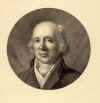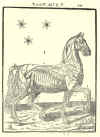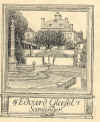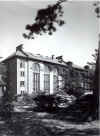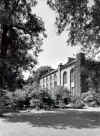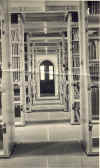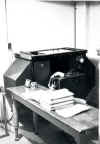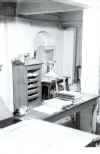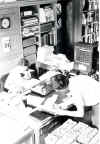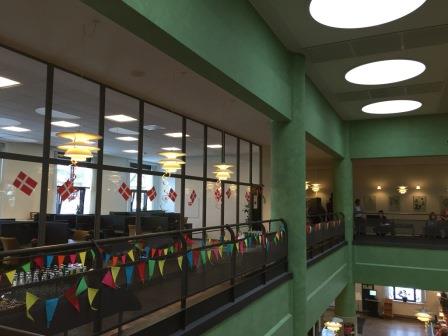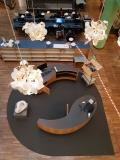History of the library
|
The first card catalogue |
|||||||||||||
|
|||||||||||||
| Rapid growth in the book collection Raphael Meyer (1869-1925), cand.mag., was librarian from 1903 until his death. During his time, the big 1894 catalogue was expanded by several supplements, and finally, in 1921, by a big comprehensive supplement for acquisitions in the period 1895-1916. This catalogue was the last printed catalogue, and it is bigger than the 1894 catalogue. The Library's book collection had thus grown by more than 50 % in 20 years. The acquisitions included several substantial book collections from KVL-lecturers. A number of special collections were also incorporated, among them working drawings for gardens and parks by Edvard Glæsel (1858-1915) - the great landscape architect of the age whose fine book collection was also incorporated, and which can now be found among the bookplates. Many af the Library's finest books on landscape gardening are from Glæsel's collection. |
|||||||||||||
|
|||||||||||||
| One librarian and one assistant The space problems were again pressing after the major acquisitions, and in 1921 most of the Library moved into a newly built multi-storey library wing, where for a time there was space for the big and steadily growing collection. This building was demolished in 1993 in connection with the construction of the new Library. In 1908 the staff was one assistant and the librarian. By 1908 the number of books had grown to about 40.000 volumes. |
|||||||||||||
|
|
|||||||||||||
In the long period - 1925-61 - when Max Lobedanz, cand.mag. (1888-1961) was chief librarian, the staff grew somewhat more, in step with the growth in materials, duties, opening times etc. |
|||||||||||||
|
|||||||||||||
| Women and copies By 1958 the staff had grown to 12, several of them women, and this was something entirely new! The copying service was one of the new duties from 1942, and another time-consuming service was the publication of a journal index on cards from 1947, where articles from about 1500 journals were indexed. The book collection had grown to over 200.000 volumes by 1958 and the Library had gradually filled up to bursting point. Additional shelves were set up everywhere and a low basement was filled up - to the considerable inconvenience of the daily loan transactions from it for many years to come! |
|||||||||||||
|
|||||||||||||
|
The classification had gradually become obsolete. A new system of classification for books was introduced from 1950, but only in the card files, which now had to be consulted before each loan. To save as much space as possible, the books were arranged compactly in numerical order while the journals were arranged by title within the new classificaion's main groups. |
|||||||||||||
|
|||||||||||||
|
Computerisation |
|||||||||||||
|
|||||||||||||
| The new Library building The real big improvements did not come until the 1990s, while Inger Mathiesen (1935- ), cand.mag., was chief librarian (1987-98). The poor physical facilities for users, staff and materials in the old Library are clearly remembered by all of us who can now rejoice every day in the functional and attractive facilities in the big new Library, which was finally completed in 1995. There is good space for the materials here with open access to the more recent collections of books and journals. |
|||||||||||||
|
|||||||||||||
|
The Library gained its own computer system in 1992 and was one of the last research libraries in Denmark to do so. All acquisitions were from now registred in the online catalogue Agroline, and since 2002, all older registrations in the card catalogues have also been made available via Agroline. PCs became standard equipment and more and more resources were available digitally - the website being the virtual main entrance to the Library's multiplicity of services. Electronic resources and study environment Librarian Ulla W. Jeppesen (1944- ) was chief librarian 1999-2005 - a time with a heavy growth in the quantity of electronic resources. Internet access to most journals in digital form made it possible removing lots of space-consuming journals in paper. 1. Floor as a whole was cleared and accomodated an open and attractive study area giving place to even more PCs. 2,3 km of journals were discarded in 2004 or removed to the Lower Ground Floor, where the rest of the journals in paper are lined up on open shelves from 1990. Wireless net has been established at the library just as at the Campus as a whole giving easy access for all private labtops.
University merger and new name Librarian Frede Mørch (1950- ) was head of the library 2005-15 in a period with several organizational changes as a consequence of the merging of universities in Denmark. In 2007, KVL became The Faculty of Life Sciences and thus part of the University of Copenhagen. Subsequently the library became a faculty library and simultaneously a part of the library partnership CULIS uniting all libraries of the University of Copenhagen. This also resulted in the common catalogue REX and common purchase of most electronic resources. In 2008, the library changed its name to the Faculty of LIFE Sciences Library. In 2009, the opening hours have been extended to weekdays 8-20 and 10-17 at weekends.
Fusion/fission and new name - again From 2012 came new, organizational change as LIFE closed down as independent faculty and was divided, so the veterinary departments became part of the Faculty of Health and Medical Sciences whereas the rest was merged with the Faculty of Science. With that the era of the Agricultural university ended - as an independent university 1858-2006 and as LIFE Faculty under the University of Copenhagen 2007-11. The consequence for the library was clarified with the evaluation after 5 years of CULIS in October 2012. The library remains being the central library for Frederiksberg Campus - now serving 2 faculties. From April 2013 we have got a new name reflecting this reality: Faculty Library of Natural and Health Sciences - Frederiksberg Campus. The other library serving these Faculties is situated at Nørre Allé 49 and has got the same name with the addition Nørre Campus. Copenhagen University Library - Frederiksberg Librarian Marianne Grützmeier (1954- ) became new head in the spring 2015 where the library once again got a new name in connection with a general simplification of the names of the Copenhagen university libraries: Copenhagen University Library - Frederiksberg. In the spring 2015 a new much requested quiet reading room with attractive study places was inaugurated. Nearly all focus are on e-resources, e-learning and digital communication.
New layout in Atrium 2016/17 changes were again in focus. Imposed budget cuts had consequences for the library in different ways. Co-location in the building with Science IT Service and Stock meant less space for library materials, where even more had to be transferred to the closed stack, so all direct access to the physical journals ended, except for some Danish specialist journals, which are now available on free Atrium shelves. Remaining books from Atrium were collected in the Lower Ground Floor with direct access for users to newer books from 1993 onwards. Budget cuts also meant unmanned desk on weekdays 8-10. On the other hand, the physical layout of the Atrium got a qualitative boost with a special grant for a new lounge area at the entrance and a unique counter centrally located in the area, where new colours, lamps, furniture and carpets also contribute to an attractive environment.
|
|
An era ends ... a new beginning The turn of the year 2017/18 marked the completion of 234 years of history as an independent library, as CUB Frederiksberg became part of the Royal Library and at the same time administratively merged with CUB Nord as a joint library for the two largest faculties at the University of Copenhagen - Science and Health/Medicine. However both physical libraries continue as the local bases for collections, services and study environments for respectively Nørre Campus and Frederiksberg Campus. Librarian Bonnie Frisendahl (1984- ) is new head of the joint library from April 2018. |
 |

